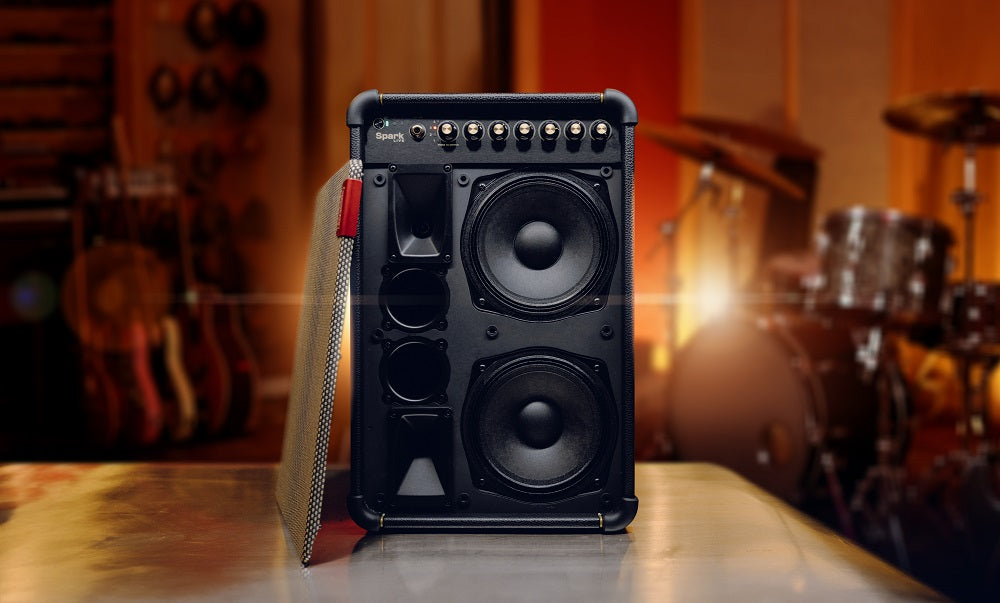
March 05, 2024By Joshua Fernandez 0 Comment
Spark LIVE, unveiled at this year's NAMM Show and celebrated in our recent article "Why we made Spark LIVE," has captivated audiences with its revolutionary approach to amplification. While our previous piece shed light on the reasoning behind this all-in-one smart amp and PA speaker, it's time to dive deeper into the technological marvel that powers it – Sonic IQ. Let's explore the intricate world of computational audio, breaking down the complexities into a journey tha audiophiles, tech enthusiasts, and musicians can embrace.
The Evolution of FRFR Speaker Design
To comprehend the revolutionary technology behind Spark LIVE, we must first understand the essence of Full Range Flat Response (FRFR) speaker systems. In the realm of guitar amplification, every guitar amp serves as an example of a non-FRFR speaker. When you plug your guitar into each amp, the sound is uniquely shaped by the amp's distinctive nuances. This is why guitarists may favor a Marshall over a Vox – each company tunes its amps with a unique design, which creates their signature sound. Think of it as if they are designing a sound filter for your guitar. However, the game changes when you plug your guitar into an FRFR speaker. In this scenario, you experience the raw, unfiltered sound of your guitar, devoid of any manufacturer-specific colorations.

Positive Grid’s Spark CAB is a full-on powered FRFR speaker.
Since the inception of FRFR speakers, they have evolved over time to meet the demands of modern musicians, transitioning towards more versatile and accurate sound reproduction for playing and recording. This evolution involves meticulous design processes, balancing elements like speaker cone material, enclosure shape, bass response, crossover design, and speaker sensitivity. This complex combination of variables eliminates biases towards specific frequencies, ensuring an accurate reproduction of the original audio signal.
Spark LIVE takes advantage of and builds on top of the latest FRFR designs, providing a neutral canvas that serves as the perfect baseline for a myriad of instruments. Positive Grid’s Spark CAB, a full-blown FRFR speaker cabinet, played a pivotal role in this journey. The lessons learned from its design laid the building blocks that would eventually become integral to the development of Sonic IQ.
Introduction to Computational Audio
So, what exactly is computational audio? To understand this concept, let's draw a parallel with the world of photography. Just as smartphones utilize computational photography to enhance and optimize images, we've taken a similar approach and applied it to the realm of speaker design. The result is Sonic IQ – a revolutionary computational audio engine at the core of Spark LIVE.

Computational audio modules for Spark LIVE
In the world of audio, much like how smartphones have transformed the photography landscape, computational audio heralds a new era. The rise of smart speakers, propelled by powerful chips, has demonstrated the transformative capabilities of these technologies. These intelligent devices can optimize sound based on user preferences, adjust for speaker position, and even adapt to the surrounding environment. And with this in mind, we designed and crafted a dedicated audio chip specifically for Spark LIVE.

 Spark LIVE being tested in an acoustic anechoic chamber to test frequency response, distortion levels, spatial audio, overall volume, and more.
Spark LIVE being tested in an acoustic anechoic chamber to test frequency response, distortion levels, spatial audio, overall volume, and more.
With Spark LIVE at its core being an FRFR speaker, providing a flat, raw, unfiltered canvas, the engineered audio chip takes advantage of this clean slate. This revolutionary chip doesn't just tweak the sound; it orchestrates a symphony of adjustments, creating clarity and balance for every instrument or sound source. Thanks to the chip’s raw processing power, it can simultaneously process audio digitally and translate it directly to the FRFR speaker, delivering a natural and clean sounding analog sound.
This includes dynamic range compression, optimized acoustics, feedback suppression, bass enhancement, vocal clarity and so much more. In other words, the chip inside Spark LIVE forms a harmonious union between its physical design, speaker configuration, and the sound that is pushed out of it. Whether it's adjusting to different instruments simultaneously or balancing sound in diverse venues, this chip performs an intricate balancing act, delivering an accurate and amazing sound experience for both performers and listeners. This is computational audio.
Sonic IQ and You
So, what does all this tech mean for you? Well, Sonic IQ isn't just a feature with a fancy name. It's the embodiment of years and years of research, expertise, and vigorous testing in speaker design and digital signal processors (or DSP for short).
Expanding on specific scenarios or use cases where Sonic IQ’s computational audio significantly enhances the performance or listening experience could further illustrate its practical value. Examples could include live performances, studio recording, or multimedia entertainment setups.
Sonic IQ computational audio merges the two into a complete package, giving you an all-in-one experience never before seen or heard in a performance amplifier.

Spark LIVE is the perfect all-in-one PA system for parties.
Watch this walkthrough of Spark LIVE to learn more. Also you can see what’s new in the Spark app. Spark LIVE is now available for pre-order.